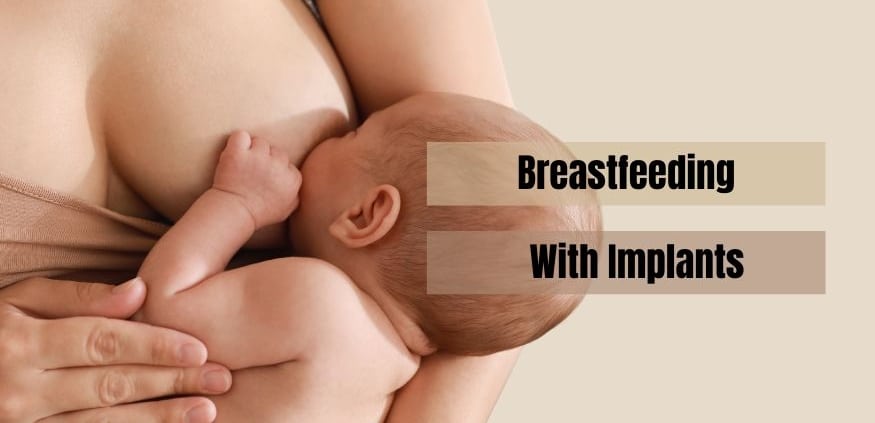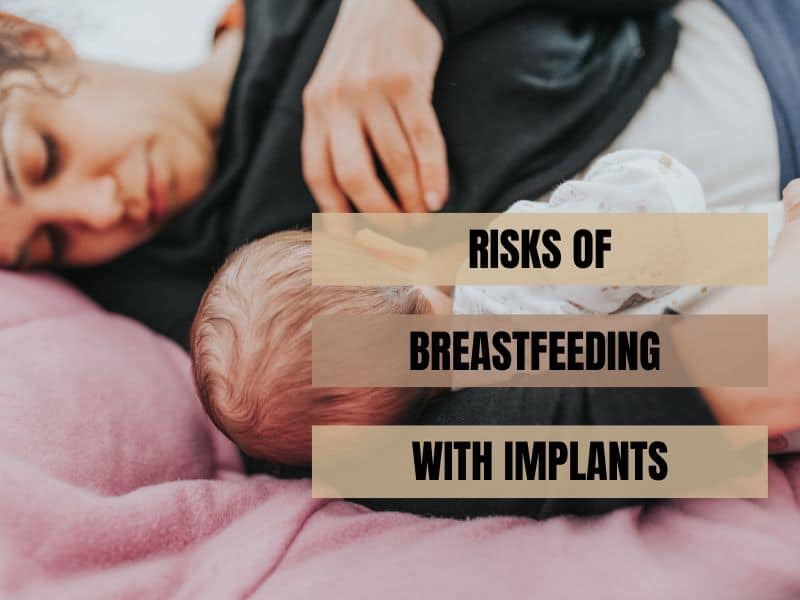Breastfeeding With Implants
Many women who either currently have breast implants or are considering them have the same question:
Will I still be able to breastfeed my baby with breast implants?
Below, we will attempt to answer this question and several other related concerns we often hear from new and soon-to-be mothers.
Can a Mother With Implants Breastfeed Her Baby?
Yes, breastfeeding is certainly possible when a mother has implants. There are some caveats, however. In some cases, for example, implants may limit a mother’s ability to produce milk. While some breast milk may be produced, she might have difficulty producing enough breast milk to adequately support her baby. Keep in mind this challenge (under-producing milk) can happen to any mother, no matter whether she has implants or not.
Factors Influencing Milk Supply in Mothers With Implants
There are three main factors that may contribute to a mother’s milk production ability when she has implants:
- The amount of glandular tissue present. Glandular tissue is the tissue that actually produces breast milk. It can sometimes be lost during breast implant surgery, or some women simply don’t have a lot of it to begin with.
- The amount of scarring in and around the milk ducts.
- The amount of overall breast tissue and nerve damage that occurred during breast surgery (often impacted most by the type of breast implant surgery performed).
We will discuss these and other factors in more depth below.
What’s important to note here is that most new mothers experience at least some challenges breastfeeding their baby — especially when it’s their first child. Things like how to best position the baby, what a good latch looks like, how often to feed the baby, and how to pump effectively all influence a mother’s ability to be successful at breastfeeding.
Key Concerns When Breastfeeding With Implants
1. Incision Location
It matters where on your body incisions were made for your breast implant surgery. Potentially, the most damaging location is around each areola. This area of the breast is crucial for the let-down reflex, which ultimately releases breast milk for the baby. When breast augmentation surgery occurs here, it is possible there will be a reduction in nipple stimulation, and nerves may be damaged.
2. Type of Surgery
Where your incisions are located largely depends on the surgical technique used by your doctor. Again, around the nipple surgical techniques tend to produce the biggest issues for breastfeeding mothers. In the armpit techniques and beneath the breast techniques often yield better results, with more nerves and glandular tissue left intact.
3. Implant Size and Positioning
In most cases, it is better to have implants placed under the layers of muscle in the breasts. Otherwise, when implants are placed over the muscle layers and between the muscle and glandular tissue, this can cause more issues. Similarly, larger implants often exert more pressure on the glandular tissue.
Both of these issues can cause breast milk-producing complications similar to engorgement.
4. Engorgement and Mastitis Issues
It’s important that a mother’s milk is able to drain well out of her breasts. However, breast implants may inhibit this process, which can lead to common breast-feeding issues such as engorgement and mastitis.
Engorgement occurs when the breasts are full or over full of milk, and draining is a problem. Engorgement usually happens during the first few months after a baby is born when the mother is still regulating how much breast milk she needs to produce. Engorgement makes it difficult to breastfeed, and it can be painful as well.
Mastitis occurs when the breast tissue is inflamed and results in an infection. This can also be painful and may lead to further medical complications.
5. Other Possible Complications
Finally, it’s important to remember that some women may experience complications during their breast implant surgery or complications after surgery that require revision or repair procedures. These can further complicate a woman’s breastfeeding success and may lead to additional damage of the glandular tissue, nerves, and milk ducts.
Are There Any Risks When Breastfeeding With Implants?
According to multiple resources, including the Centers for Disease Control and Prevention (CDC), “There have been no recent reports of clinical problems in infants of mothers with silicone implants.” At the same time, the CDC and other medical agencies bring up the fact that little research has been conducted on the safety of breastfeeding with implants.
Silicone Safety
While it is never an intention to allow silicone to enter a baby’s milk supply, it’s also important to remember that silicone (the primary material used to make most breast implants) is, as the Department of Obstetrics and Gynecology at the University of Michigan mentions, “widely present in the environment and silicone drops are commonly used to treat infants for stomach gas, or colic.”
What is of primary concern when it comes to breastfeeding newborns is that the baby is getting an adequate supply of milk. Even if a mother cannot produce enough milk to fully supply her baby with nourishment, she may still choose to provide what breastmilk she can and supplement with formula. Doing this is perfectly fine, and it is much better than attempting to supply your baby with entirely your own breastmilk when you’re having difficulty producing or latching your baby. This can cause serious health concerns for newborns, who will not be getting the nutrients they need to grow and thrive.
Frequently Asked Questions
Do breast implants make breastfeeding more difficult?
Breastfeeding with implants is usually not more difficult, but it can depend on the placement of the implants and the surgical technique used. If the milk ducts or nerves were affected during surgery, milk production could be reduced. However, many women with implants can breastfeed successfully.
Is it safe to breastfeed with implants?
Yes, it’s generally safe to breastfeed with implants or after a breast augmentation surgery. The materials used in breast implants, such as silicone or saline, do not pose a risk to the baby, and breastfeeding can often be done without issues. However, it’s important to discuss with your surgeon if any specific concerns apply to your case.
Can breast reduction affect breast milk production?
In the case of breast reduction, the surgery can affect milk production. The procedure may remove glandular tissue or impact milk ducts, potentially reducing breast milk supply. However, many women are still able to breastfeed successfully after breast reduction surgery, though outcomes vary depending on the surgical technique used.
Do You Have Other Questions About Breastfeeding After Implants?
As stated above, we often get questions from mothers concerning breastfeeding and cosmetic breast implants. If you are considering breast implants, or breast augmentation but aren’t sure if it’s right for you because you plan on becoming pregnant at some point after your surgery, we welcome you to book an appointment with Sieber Plastic Surgery today to discuss your options. Dr. Sieber would be happy to speak with you about any questions you may have and help clear up any concerns.
References
- https://www.cdc.gov/breastfeeding/breastfeeding-special-circumstances/maternal-or-infant-illnesses/breast-surgery.html
- http://www.med.umich.edu/1libr/Gyn/Lactation/BreastfeedingAfterBreastImplants.pdf






